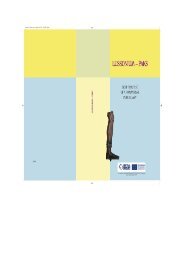the PDF version! - Danube Limes
the PDF version! - Danube Limes
the PDF version! - Danube Limes
Create successful ePaper yourself
Turn your PDF publications into a flip-book with our unique Google optimized e-Paper software.
Frontiers of <strong>the</strong> Roman Empire – Ripa Pannonica in Hungary (RPH) Nomination statement<br />
of Pannonia were replaced with enormous round towers. However, except for a fortification begun<br />
in Barbaricum this never occurred on <strong>the</strong> fortifications along <strong>the</strong> border, which indicates a perilous<br />
decrease in <strong>the</strong> attention paid to <strong>the</strong> limitaneus units.<br />
Evidence of late Roman construction or alterations is lacking in <strong>the</strong> two legionary fortresses. The final<br />
construction project of <strong>the</strong> fortress at Aquincum was <strong>the</strong> remodeling of <strong>the</strong> porta praetoria, which can be<br />
placed during <strong>the</strong> period of <strong>the</strong> Tetrarchy. However, this fortress was abandoned soon after, and in place<br />
of it a new fortress was built to <strong>the</strong> east of its walls during <strong>the</strong> time of Constantine.<br />
In contrast to <strong>the</strong> legionary fortresses, we know of late Roman construction at essentially every earlier<br />
auxiliary fort (castellum) where <strong>the</strong>re have been excavations. The new fortifications in <strong>the</strong> late Roman<br />
period broke from <strong>the</strong> earlier principles in <strong>the</strong>ir ground plans, which adapted considerably to <strong>the</strong> terrain<br />
(e.g. Visegrád–Sibrik-domb fort).<br />
The final construction period of <strong>the</strong> Ripa Pannonica occurred at <strong>the</strong> turn of <strong>the</strong> 5 th century, when towerlike<br />
forts with dimensions of 10-30 m were erected, sometimes on <strong>the</strong>ir own and sometimes within <strong>the</strong><br />
area of <strong>the</strong> existing forts. This fact clearly indicates that when <strong>the</strong>y were built <strong>the</strong> numbers of soldiers at<br />
<strong>the</strong> forts were no longer large enough to ensure <strong>the</strong> proper protection of <strong>the</strong> several hundred meters of<br />
walls of <strong>the</strong> old forts. In <strong>the</strong> case of Lussonium, a few meters inside of <strong>the</strong> sou<strong>the</strong>rn gate of <strong>the</strong> late Roman<br />
fort, a portion of a 10 × 9 m fortlet with 2.3 m thick walls was successfully excavated.<br />
The soldiers of <strong>the</strong> Ripa may have been forced to construct <strong>the</strong>se fortlets in <strong>the</strong> years after <strong>the</strong> death of<br />
Theodosius (379-395 AD). The construction of <strong>the</strong> towers can at <strong>the</strong> latest be linked to <strong>the</strong> re-organizational<br />
activities related to <strong>the</strong> person of Generidus dux in <strong>the</strong> first decade of <strong>the</strong> 5 th century. Their maintenance,<br />
or ra<strong>the</strong>r <strong>the</strong>ir use by military forces organized by Rome, lasted for about <strong>the</strong> next two decades until a<br />
new situation developed as a result of <strong>the</strong> Huns appearing on <strong>the</strong> Great Hungarian Plain (433 AD), when<br />
a significant portion of Pannonia, including <strong>the</strong> section of <strong>the</strong> border in <strong>the</strong> territory of Hungary was<br />
relinquished.<br />
Watch towers and signal towers<br />
The watch towers and signal towers 1 , which only rarely can be differentiated, were quite small structures,<br />
and when <strong>the</strong>y were built from wood <strong>the</strong>y have left hardly any trace on <strong>the</strong> surface.<br />
It was natural that from <strong>the</strong> time of Tiberius and Claudius, with <strong>the</strong> beginning of <strong>the</strong> permanent military<br />
presence on <strong>the</strong> Ripa, <strong>the</strong>re was a need for a more assertive control over <strong>the</strong> borderline, even though a<br />
good relationship had been created with <strong>the</strong> peoples on <strong>the</strong> o<strong>the</strong>r side through treaties. This manifested<br />
itself primarily with <strong>the</strong> construction of auxiliary forts, and not of watch towers. The guarding of <strong>the</strong> river<br />
border at this time was instead presumably performed through regular patrols. However, by <strong>the</strong> end of<br />
<strong>the</strong> 1 st century at <strong>the</strong> latest – according to evidence on Trajan’s Column – a series of watch towers along<br />
<strong>the</strong> border had become customary.<br />
1<br />
Watch tower (in latin: burgus) – Multilevel military building along <strong>the</strong> limes and <strong>the</strong> limes road. Its lateral length rarely<br />
exceeds 10 m.<br />
Signal tower (in latin: burgus) – Member of a series of observation posts along <strong>the</strong> limes road suitably settled to transmit military<br />
signs within eyeshot and earshot. In some cases, where <strong>the</strong> limes road swings away from <strong>the</strong> river-bank, – in addition to <strong>the</strong> signal<br />
tower-chain – extra watch towers were built on <strong>the</strong> bank. (The two kinds of towers do not typologically differ from one ano<strong>the</strong>r<br />
apart from <strong>the</strong>ir localization.)<br />
Fortified river port (in latin: burgus, “bridge head fort” by <strong>the</strong> deep-rooted expression of <strong>the</strong> Hungarian literature) – Fortlet<br />
with two wing-walls protruding into <strong>the</strong> river, built in pairs on <strong>the</strong> opposite banks of <strong>the</strong> <strong>Danube</strong>.<br />
38











